 |
|
| Lebanon staging point. Sign says “Iran’s Garden” (AP) |
http://lennybendavid.com/2011/05/one-if-by-land-and-two-if-by-sea.html
There are remarkable similarities between the Mavi Marmara flotilla in May 2010 and the Nakba marches from Lebanon, Syria and Gaza on May 15. The Israeli intelligence services seriously underestimated their threats, and IDF soldiers were unprepared for the violent ambush that awaited them. The media portrayed Lebanese, Syrians and Palestinians as unarmed civilians in both cases. The Israeli army’s reaction was deemed by some as disproportionate and possibly in violation of international law. And Lebanon’s government copied a page out of Turkey’s play book and screamed about Israeli war crimes.
In 2010 it took days for the world to learn the true belligerent nature of the Mavi Marmara‘s passengers. They may have been in civilian garb, but they were determined combatants nonetheless. Such was also the case in the Gaza, Maroun al-Ras, and Majdal Shams invasions.
Many of the photographs of the May 15 Nakba incursions have not been published in the media, but they are posted on the news agencies websites for purchase. Almost 200 can be found on Yahoo’s news photo website. [Photos from Reuters and AP are presented here for illustrative and educational purposes and not meant for commercial use.]
Analysis of the pictures provides several important lessons.
All of the Nakba cases involved the illegal invasions of Israeli territory or areas under Israeli sovereignty. Hamas was behind the attack at the Erez Crossing from Gaza, the Syrian government organized the recruitment and busing of hundreds of Syrian-Palestinians to Majdal Shams on the Golan Heights, and Hizbullah paid for and organized the assault at Maroun al Rus. These were not cases of a lost shepherd or tourist accidently crossing the border. The IDF had every right to respond to the invasions with force.
Southern Lebanon is predominantly Shi’ite. The Sunni Palestinians were bused in by the thousands from refugee camps around Lebanon. “Lebanese activists also took part in the march, which counted Hizbullah among its organizers, the Beirut Daily Star reported on May 16. Naharnet reported, “The organizers of the rally told AFP that Hizbullah had financed the events.”
 |
| 1. note the flags and the treeline. |
Close inspection of photos show Hizbullah’s involvement. One of the men accompanying a wounded man in this APphoto (1) appears to be carrying unfurled Hizbullah banners. But the picture at the top of this blog makes it very clear. The sign above the assault’s staging area in Maroun al Ras bears Iran’s symbol and the words “Iran’s Garden.”
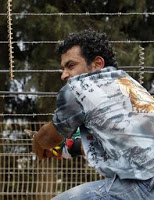 |
| 2. Cutting the fence |
Pictures prove the hostile intention of the assaults. This picture to the left (2) shows a man with wire cutters attempting to cut through the fence between Lebanon and Israel. He has already passed other wire barriers. Israeli soldiers stand on the other side of the fence beneath the trees.
The next photo (3) shows the “charge” of the mob to the fence. Israeli soldiers are beneath the trees
 |
||
| 3. Charging the line |
The next picture (4) shows men attempting to breech the fence and establish a “beachhead.” They’re taking cover from Israeli gunfire. Note the man in the striped brown shirt on the right top. He later shows up in a Reuters photo (5) wounded on a stretcher hundreds of meters from the treeline, heading up the hill to the staging area of “Iran’s Garden.”
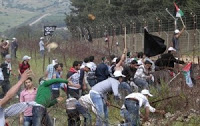 |
| 3b. Charging the fence – continued |
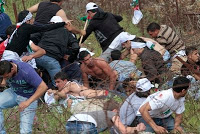 |
| 4. Attempt at a “beachhead” |
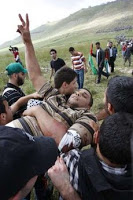 |
|||
| 5. Brownshirt wounded |
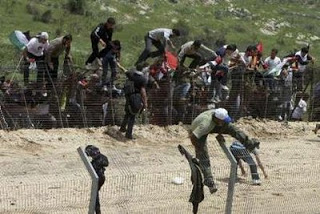 |
| 6. How it was done on the Syrian front |
On the Syrian front, note how the attackers successfully scaled the fences (6) and then proceeded to attack an IDF jeep. (7)
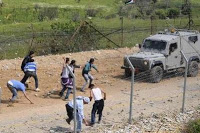 |
| 7. Attacking an IDF jeep |
There were reports that some of the mob on the Lebanese front were killed by Lebanese soldiers, but it appears from the pictures that the Lebanese inflicted a few bruises at best. To reach the Israeli border, the Maroun al Ras mob actually had to pass a company of Lebanese soldiers. In picture (8) the soldiers can be seen above the black fold in the larger flag. In photo (9) the soldiers are successfully blending in with the vegetation. Again, the treeline is Israel, and the Lebanese soldiers just stood there hundreds of meters away.
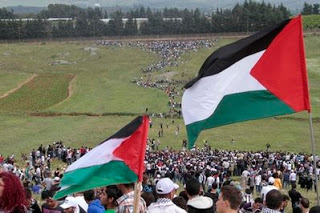 |
| 8. Army company grouped above the black fold of the top flag. |
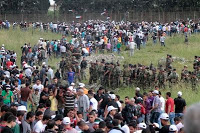 |
| 9. How did they get past the army? |
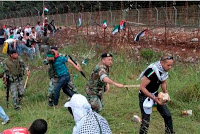 |
| 10. Naughty, naughty! |
There are several almost comical photographs of Lebanese soldiers trying to restrain a few rock-throwers with their batons. (10) Meanwhile, the mob behind them is attempting to breech the fence.
Is there anyone in Washington still serious about providing weapons to the Lebanese army?
View the pictures of the UN peacekeeping forces along Israel’s border with Lebanon and Syria — UNIFIL and UNDOF — trying to stop the incursions and protect the peace. Oh, wait, there are no such pictures because the force mandated to keep peace was nowhere to be seen when Israel’s sovereignty and security were under attack. So much for the idea floating around Washington to meet Israel’s security demands in a peace agreement with the Palestinians by providing a foreign peacekeeping force on the West Bank.
· * “One if by land, and two if by sea” was the signal for warning lanterns posted in a church steeple to warn of the British approaching Boston in 1775, part of the story of Paul Revere’s famous ride.









